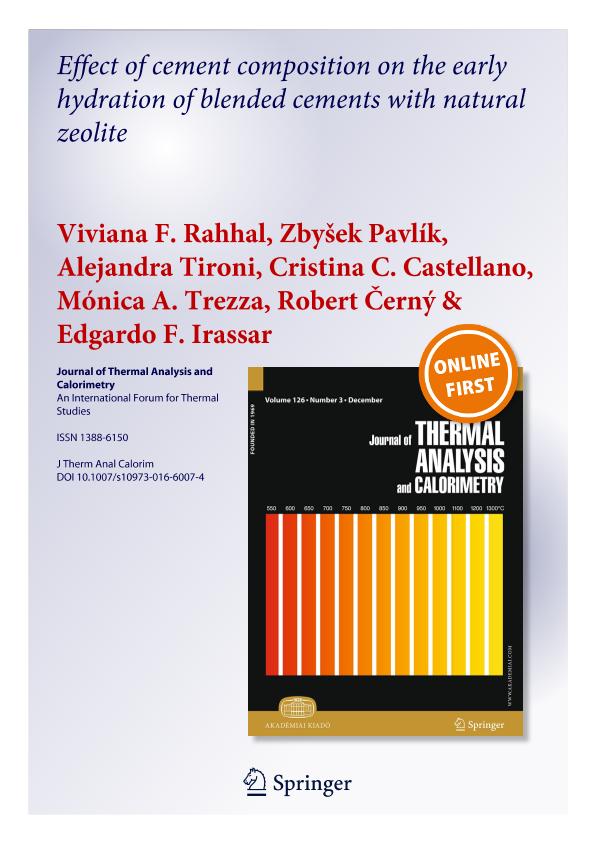Artículo
Effect of cement composition on the early hydration of blended cements with natural zeolite
Rahhal, Viviana Fátima; Pavlík, Zby?ek; Tironi, Alejandra ; Castellano, Claudia Cristina; Trezza, Mónica Adriana; Černý, Robert; Irassar, Edgardo Fabián
; Castellano, Claudia Cristina; Trezza, Mónica Adriana; Černý, Robert; Irassar, Edgardo Fabián
 ; Castellano, Claudia Cristina; Trezza, Mónica Adriana; Černý, Robert; Irassar, Edgardo Fabián
; Castellano, Claudia Cristina; Trezza, Mónica Adriana; Černý, Robert; Irassar, Edgardo Fabián
Fecha de publicación:
05/2017
Editorial:
Springer
Revista:
Journal of Thermal Analysis and Calorimetry
ISSN:
1388-6150
Idioma:
Inglés
Tipo de recurso:
Artículo publicado
Clasificación temática:
Resumen
This paper studies the addition (0–40% w/w) of natural zeolite (NZ, 84% clinoptilolite) in blended cements made with Portland cement (PC) with low and medium C3A content. The isothermal calorimetry was used to understand the effect of NZ on the early cement hydration. For low C3A cement, the addition of NZ produces mainly a dilution effect and then the heat released curve is similar to plain cement with lower intensity. For medium C3A cement, the curve shows the C3S peak in advance and a high intensity of third peak attributed to C3A hydration. The high cation fixed of NZ reduces the ions concentration (especially alkalis) in the mixing water stimulating the PC hydration. The flowability decreases when the NZ replacement level increases. Results of Fratini’s test show that NZ with both PCs used presents slow pozzolanic activity. At early age, XRD and FTIR analyses confirm that hydration products are the same as that of the corresponding PC and the CH is progressively reduced after 28 days and some AFm phases (hemi- and monocarboaluminate) appear depending on the NZ percentage and the PC used. For low replacement levels, the compressive strength is higher than the corresponding PC from 2 to 28 days. For high replacement levels, the early compressive strength is lower than that of corresponding plain PC and the pozzolanic reaction improves the later compressive strength of blended cements.
Palabras clave:
Cation Exchange
,
Cement
,
Clinoptilolite
,
Hydration
,
Isothermal Calorimetry
,
Zeolite
Archivos asociados
Licencia
Identificadores
Colecciones
Articulos(CIFICEN)
Articulos de CENTRO DE INV. EN FISICA E INGENIERIA DEL CENTRO DE LA PCIA. DE BS. AS.
Articulos de CENTRO DE INV. EN FISICA E INGENIERIA DEL CENTRO DE LA PCIA. DE BS. AS.
Citación
Rahhal, Viviana Fátima; Pavlík, Zby?ek; Tironi, Alejandra; Castellano, Claudia Cristina; Trezza, Mónica Adriana; et al.; Effect of cement composition on the early hydration of blended cements with natural zeolite; Springer; Journal of Thermal Analysis and Calorimetry; 128; 2; 5-2017; 721-733
Compartir
Altmétricas



